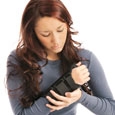How many times has a student come up to say he can’t play today? Perhaps the statement was uttered in a plaintive or apologetic tone, often accompanied by a bandage, cast, or crutches to accentuate the significance of the occasion. Unfortunately, the phrase is all too common, and it is a frequent source of difficulties during rehearsals – especially when preparing for a concert, festival, or tour.
Of all the physical difficulties that may prevent students from participating in instrumental music, acute injuries or trauma and overuse-related problems are by far the most common. It can be useful to have some background on these problems, their causes, the teacher’s role in treatment and rehabilitation, and some strategies for prevention.
During three decades as an orthopedic specialist and hand surgeon, I’ve seen many young musicians with hand and upper extremity problems that interfered with practice and performance. School musicians ages 8-18 experience both acute injury and problems from overuse.
Acute Trauma/Injury
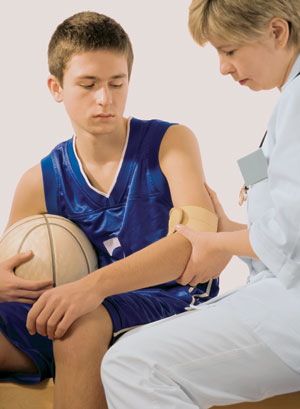 By far, the most common cause of acute hand or upper extremity injury was playing sports; about 62% of my young patients described this as the cause. Of the problems produced by acute trauma, fractures accounted for more than half of the injuries; broken finger bones were the most common, followed by fractures of the forearm bones just above the wrist joint. Sports seemed to be the primary cause of finger bone fractures, while falls onto an outstretched arm accounted for the majority of wrist fractures.
By far, the most common cause of acute hand or upper extremity injury was playing sports; about 62% of my young patients described this as the cause. Of the problems produced by acute trauma, fractures accounted for more than half of the injuries; broken finger bones were the most common, followed by fractures of the forearm bones just above the wrist joint. Sports seemed to be the primary cause of finger bone fractures, while falls onto an outstretched arm accounted for the majority of wrist fractures.
Sprains of ligaments around the joints accounted for about 20% of the diagnoses; most of these occurred in the fingers, especially the middle joint. Other diagnoses were dislocations of joints, lacerations (some involving tendons and nerves), contusions, and muscle strains. A few musicians had problems related to prior traumas; these could be considered complications or untreated conditions, and many of the instrumentalists so afflicted had a less-than-satisfactory outcome to treatment.
Acute injuries are hard to avoid, but students should take a few precautions when playing sports.
1. A preseason warmup for the hands is important when resuming any sport that uses a ball. I’ve found that most injuries sustained while playing these sports were caused by catching the ball with the hands in the wrong position, and the majority of these occurred early in the season, before athletes had fully regained sports-specific skills.
2. Wear protective equipment, correctly sized and appropriate to each sport, for all practices and games. Although it seems inconceivable to think that symphony musicians would play a pickup game of softball barehanded during summer festival rehearsals, it has happened more than once.
3. Recognize that pain is a warning signal that something is wrong; heed it by stopping the painful activities and resting the injured area.
4. Seek early, expert care for any problem. Don’t try to play through the pain and hope it will go away. What you do in the first few hours or days after an injury usually determines how well you recover later.
Overuse
Physical problems related to musical or other forms of overuse are the second most common cause of young musicians’ painful difficulties. Although many people list overuse as a diagnosis, it really describes a spectrum of causes. This is my definition (and that of the Standards Committee of the Performing Arts Medicine Association):
Overuse is a practice or activity in which anatomically normal structures have been used in a so-called normal manner, but to a degree that has exceeded their biological limits. This produces certain physical changes, which often are accompanied by corresponding symptoms or complaints. The degree of excessive activity needed to produce these results varies from person to person and seems to be related to one’s anatomy and physiology. Some of the factors involved include genetic makeup, age, level of physical conditioning, degree and duration of music training, and variety of life stresses.
More than 80% of overuse problems in my young musician patients were caused by making music. String and keyboard players formed the vast majority (75%). The highest percentage of these problems occurred in collegiate and conservatory music majors – not surprising considering their long hours of practice and performance.
There are many types of overuse and many associated risk factors. Whether from music, sports, or work, the syndromes are similar. Three basic factors – time times intensity, technique, and genetics – contribute to overuse in musicians, and all are influenced by the amount of time a person practices and performs on an instrument.
Rapid increases in either or both intensity and duration of playing can combine to create an overuse situation. Some examples include changing to a new school; working with a new instructor, employer, instrument, or repertoire; adding additional instruments; and rapidly increasing practice time or associated activities, such as reedmaking. If the excessive activity continues, it places the body at risk for developing problems. Away from music, the demands of daily routine, as well as intense athletic activity, also may lead to overuse.
Technical factors include such items as improper playing techniques; some would call this misuse. Some examples include using abnormal body postures while playing; excessive pressure or force on keys, strings, mallets, or sticks; or a physical mismatch between a player and an instrument, such as small students playing excessively large violas or tubas.
Genetic factors are conditions over which neither musician or physician has any control. Hypermobility (lax ligaments or double-jointedness) is the most common one, affecting 5-8% of the population, and is more common in females and the young. Hypermobility is associated with an abnormally large range of joint movement, which may affect hand and finger placement on keys or strings, leading to technical difficulties and excessive compensatory muscle use.
Gender is another risk factor; many studies have shown that females are more likely to develop overuse-related problems than males because of their smaller average hand size and muscle strength. Any player of a large instrument is more likely to develop difficulties because of instrument size, complexity of keywork, and greater force needed to make music; consider the differences between trumpet and tuba, violin and double bass, and alto and baritone saxophones. The larger instruments demand a greater reach and wider stretches of the hands and fingers, requiring extra muscle tension and activity. This explains why smaller students may not be physically able to play tubas, baritone saxes, or standard bassoons.
Problematic Instruments
Overuse problems often are related to the type of instrument played. Pianists are more likely to develop problems in the right hand, while upper string players and guitarists usually complain of left-hand symptoms. Musicians playing lower string instruments will complain of problems in the left hand and spine. Woodwind players develop thumb difficulties from supporting their instruments; the right hand is more commonly involved with clarinet and oboe players, while it’s the left hand for flutists. Brass musicians have a low prevalence of overuse problems, and no one anatomic area predominates. Percussionists are at increased risk for wrist and shoulder problems.
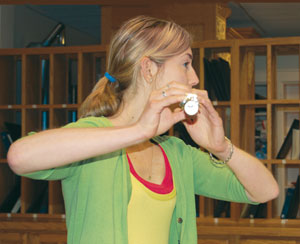
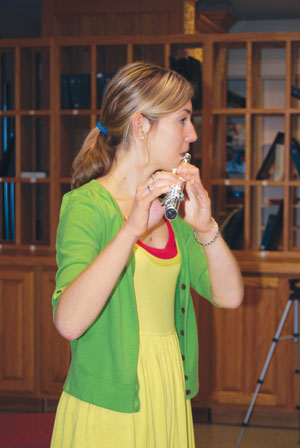
First and foremost, music teachers should watch for poor posture in students when playing. Students who do not play with a relaxed posture (as in the bottom picture) may develop injuries over time.
Overuse primarily affects the musculoskeletal system; the most common condition it produces is muscle or tendon strain (akin to a sprain of ligaments, but occurring in muscles). Rapid and repetitive movements of muscles and tendons can result in inflammation of the tendons where they rub across a joint, a condition known medically as tendinitis or tenosynovitis. Strains and inflammation account for three fourths of overuse-related conditions. Uncom-monly, nerves may be compressed or irritated by repetitive use, principally in the hand or fingers.
Music teachers can help recognize these problems by watching students practice and perform in a variety of situations and identifying potentially troublesome practices or conditions. Modifying a practice and performance can fix such a situation.
Teachers can also prevent problems by monitoring correct playing techniques, watching for tell-tale signs of problems. Seeing a student drop an arm and shake it indicates discomfort; so does abnormal stretching or rubbing of the neck. Some students fidget out of boredom, but often it is a response to discomfort. The student who peers at the music, head held close to the stand in typical bad posture, may actually be squinting to see the page because of poor vision. Correcting nearsightedness or astigmatism can help with proper posture and comfortable playing.
Return to Playing
Both music teachers and students should know how and when to permit a student to return to playing. Ideally, this would occur when pain is absent and flexibility, muscle strength, endurance, and coordination – some or all of which may have been lost or decreased during the time of treatment – have been regained. Often, practice routines or techniques may need modification, most commonly by a gradual resumption of practice time, intensity, and difficulty.
After an injury, it is important to avoid too rapid a return, which might result in a recurrence of the same problem or a new and different problem. A written program can be useful, but it should be tailored to the student, instrument, and type of problem. In some cases it may be wise to increase practice sessions by only 5-10 minutes at a time and maintain the same intensity for several days or weeks.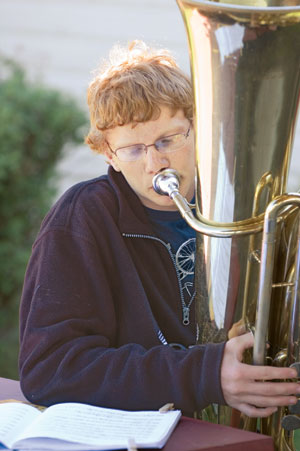
Early therapy may help to restore functions lost during the treatment process; this might include mouthpiece buzzing or one-handed playing (with the uninjured hand). It’s also possible to combine medical and musical rehabilitation in consultation with the student’s medical professionals. Exercises at the instrument can be designed to achieve specific rehabilitation goals, such as increasing hand span or finger coordination.
Prevention
Practice habits are an important part of prevention and are easily modified. Work with students to determine playing times and intensity carefully. Preparation for auditions, recitals, and juries should be planned as far in advance as possible, and daily practice should be increased in small increments rather than all at once.
The 25-5 rule should become a lifetime habit: play or practice 25 minutes, followed by five minutes of rest. Do this every half-hour and get away from the instrument during breaks; mental rest is as important as physical rest. Vary both practice patterns and material; recognize the potentially damaging effects of different types of repertoire. Practice times should minimize stressful repetition of passages, especially when little musical progress seems to be made. Finally, help students build up playing endurance in all necessary muscles, including the embouchure.
The instrument is another component. In misuse, normal body tissues are used in an abnormal way, producing a variety of problems. First and foremost, music teachers should watch for poor posture in their students when playing. I’ve found it useful to ask students to stand or sit in correct posture without the instrument, then move to the instrument (keyboards, percussion) or bring it to the body. In this way they can maintain correct posture, adapting the instrument to themselves, which is the basis of proper ergonomics and effective music-making.
Correct posture also includes proper hand and finger position on keys or strings, or while holding bows, sticks, or mallets. Indeed, the entire arm, from shoulder to fingertips, should be considered. During playing, watch for abnormally strong or vigorous hand movement, inappropriate to the type and dynamics of the music being played. This is a component of misuse and needs correction.
Finally, observe how each student sits: chairs or benches should be at the proper height for playing, and in ensembles, seats should be correctly separated and facing in the proper direction. How often have we seen a semicircle of flutists, far too many for the size of the row, with their torsos twisted to the right and their right elbows held way behind the back of the chair? To see both the music and director, they must turn their necks to the left, sometimes excessively so. These conditions do not encourage efficient playing, from both a respiratory and a muscular standpoint, and they are not confined to flutists.
Modifying the instrument in some way may help students who have physical problems in playing. This is especially true for small students who have difficulty holding or playing a large instrument. Correct instrument support can minimize muscle force and physical stress, increasing playing efficiency. Here are a few useful modifications:
• The flute can be padded with commercially available adhesive pads that permit the hands to maintain a more normal attitude, minimizing force on fingers and hands.
• A neckstrap will take most of the instrument weight off the right hand of clarinetists and English hornists; oboists won’t benefit as much from neck straps, because they hold the instrument farther away from the body. Instead, consider a chair support; they can help oboists more, but they do limit some body movement while playing.
• Seated bassoonists should rely on seat straps or, alternatively, floor pegs for support; to minimize neck discomfort and reactive muscle contractions, avoid neck straps, even while standing. From personal experience, I know that shoulder straps are more comfortable.
• Floor pegs are extremely helpful to support bass and contra clarinets; with them, a neck strap may be necessary only for minor control of position.
• Body harnesses distribute the weight of all saxophones, bassoons, and tubas; even playing an orchestral tuba is less stressful to players who wear a harness.
• Upper string players should find a comfortable combination of chin and shoulder rests; the player’s head should not be excessively tilted or rotated to the left, and there should be minimal force on the left side of the lower jaw. Trial and error is the best way to determine the most comfortable combination, and the position should be evaluated regularly as students grow. Changing to a larger instrument may necessitate a new setup.
Relaxed Playing
Avoiding overuse during practice and playing with proper technical considerations can help instrumentalists to achieve what I call “playing relaxed.” Obviously, not all the muscles will be relaxed when making music, but ideally the unnecessary muscles will be. Using only the muscles needed to produce beautiful sounds is clearly the most physically efficient option and can minimize or avoid overuse-related difficulties.
When the hand and arm are at rest, all its muscle groups are relaxed, quiet, and in balance. You can experience this by hanging an arm down at your side, totally relaxed, for ten seconds. Now, look down at the hand without moving it or tightening any muscles; what you see is the hand at rest. Starting from this position, all movements will be efficient and take the least muscle effort regardless of direction. Next, bring this hand to the instrument. The goal is to keep the hand as close as possible to the rest position.
A second aspect of playing relaxed is to avoid using opposing groups of muscles in a single task. For example, when both the flexor and extensor muscle groups in the forearm are used simultaneously, a condition known medically as cocontraction occurs; the arm tightens up, making movements sluggish and slow because the two muscle groups are fighting each other – hardly an ideal situation for playing rapid notes. Consciously using only the needed muscles to do the job doesn’t usually come naturally to most people; it takes practice to isolate these groups to do just what you want them to do. The result, however, is ideal for comfortable, continuous playing of any musical repertoire – fast or slow.
Minimizing mental distractions or stress can also decrease muscle tension and make cocontractions less likely. It often takes conscious effort to tune out unwanted thoughts. A final factor is being comfortable with the instrument, which relates to efficient playing posture and instrument support.
Environmental controls go somewhat beyond the topic of overuse but are as critically important to all musicians as practice and technique controls. Adequate separation between chairs is essential, especially in the case of cellos, double basses, saxophones, bassoons, and tubas. Enlarging the radius of chairs from the podium is an effective way to achieve this without altering seating arrangements.
Sufficient light is important, and not a problem in most rehearsal halls and classrooms. However, light levels on stage or in an orchestra pit may be another matter. Stand lights, if used, should be of high enough wattage and give a spread of light that illuminates the entire printed page. Newer LED stand lights may have promise over incandescent bulbs.
Too Much Sound
Another serious, widespread problem for instrumentalists is prolonged exposure to excessive sound levels, which has long been known to damage hearing. Short-term exposure to loud sounds may cause a temporary diminution of hearing, often accompanied by a ringing sensation in the ears, called tinnitus.
However, prolonged or repetitive exposure produces a condition known as noise-induced hearing loss (NIHL), a permanent type of nerve deafness that cannot be treated satisfactorily. NIHL also may have associated tinnitus, and it is a cumulative problem that gets progressively worse with increasing levels and duration of exposure. It affects all ages and skill levels of musicians and can be caused by all genres of music. Studies have shown that orchestral instruments can produce sound levels approaching those of jackhammers or jet planes.
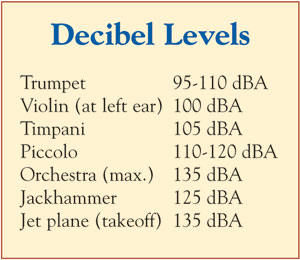
The National Institute of Occupational Safety and Health (NIOSH) recommends that cumulative daily sound exposure not exceed an average of 85dBA (decibels). If sound levels increase, exposure times must decrease proportionately. NIOSH recommends that for every 3dBA increase in sound level the exposure time be cut in half. While school band and orchestra directors are at greatest risk for NIHL, considering the number of hours each day they devote to ensemble rehearsals, students are at risk too, especially if they play in marching or jazz ensembles.
Hearing Protection
Prevention is the only way to control NIHL. Excessive sound levels must be decreased, and there are many ways to do this. For example, a director may have the ensemble practice more softly or minimize repetition of very loud passages. Placement of musicians on risers also can affect sound levels, a useful consideration for jazz or groups. Some symphony orchestras have placed clear plastic sound baffles between rows of musicians, especially in front of loud instruments such as trumpets, piccolos, and percussion. Newly constructed music rehearsal rooms should have high ceilings, nonparallel walls, and liberal use of sound-absorbent surfaces on walls and ceilings.
Individual hearing protection is another form of prevention. Stage musicians now have the option of using in-ear monitors, which are more effective than the old-style speakers placed at the front of the stage. Wearing attenuators (sound-limiting earplugs) can lower sound levels as much as 25 dBA – a significant drop. Several varieties are available, some for as little as $10 a pair. These inexpensive ones can be bought in bulk by band and orchestra directors for their students.
Using attenuators will make each musician more aware of his sound and the adjustments in dynamics necessary to maintain correct balance. Getting used to a different perception of sound balance – and accepting it as the new normal – can be difficult, but it is by no means impossible.
In the past 25 years, an increasing number of health professionals have become aware of musicians’ difficulties, and more are now experienced in caring for this extensive population. The Performing Arts Medicine Association, an international society of health care and artistic specialists, has a referral service for musician patients through their website. Additionally, there are many books and articles written by experienced, reputable arts medicine specialists for performers of all ages and their teachers. For directors with further concerns, questions, or interest, information and help is as close as the internet or telephone.
